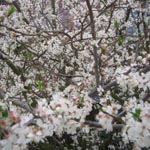1 2 3 4 5 6 7 8 9 10 11 12 13 14 15 16 17 18 19 20 21 22 23 24 25 26 27 28 29 30 31 32 33 34 35 36 37 38 39 40 41 42 43 44 45 46 47 48 49 50 51 52
Gardening diary week 9 beekeeping blog
Seed sowing begins in ernest for plants to be raised in the greenhouse. Root vegetables, peas and beans can be sown outdoors.
Diary week nine Feb 26th - March 4th
February 26th Pictures
2008
Monday March 3 2008 pictures
Sunday March 2nd 2008 The wind eased and by the end of the day started to change direction. We are going to get some cold air from the North West.
There is a metal post that was the corner of my old compost heap that I'm trying to dig out but it is in mighty deep and I ran out of light to have been able to get it out today.
In the allotment I dug around one of my small pear trees. I have two small pear trees both rejects given to me by other plot holders. In most recent years they each have a few small pears on and each year I give them copious amounts of muck to try and keep them happy. They don't make much growth and I think they have yet to get settled down and really start growing. They must be on a dwarfing rootstock and I think these rootstocks take a long time to get going. My small apple trees have been growing in their current sites for well over twenty years and only in recent years do the seem to have got a grip and started really growing well.
In the garden I turned over the black compost bin and put half back that needed more time to rot.
Pictures Saturday 1st of March 2008 We had strong winds and hailstone in the night although by morning the wind had dropped somewhat it was still a windy day. My stack of spare supers was blown over in the allotment and a bag of pots was blown all over the place along with a bag of packing chips both of which I had just cleared out of the shed. I fed the bees in Costesy with the exception of one hive that I have lost. The tasks that needed doing last week -- the gooseberries and the compost bin -- still need doing.
The week has had it's fare share of both sun and rain so far (Thursday 28th) I have finished pruning the apple trees and the vine supported on the side of the shed. I still have quite a few gooseberry bushes left to prune and two more compost bins to build. The snowdrops are fading as is the blossom on the earliest of the cherry plums although several of the other cherry plum trees have just come into full bloom. There are cherry plum trees blooming all over the city now. Many of them are a selected purple leaved pink blossomed variety that I guess must have been grafted onto a root stock to maintain the uniformity of leave colour and tree size. Those that I have grown from seed come in many shades of purple to green and different shapes and sizes.The greengage trees are still some way off from coming into bloom.
I feed several of the hives of bees today and intent to give them all at least a little something to keep them going in order to build up their strength and numbers.
2007 Monday February 26th 2007. Another damp day. It hasn't been cold in the last week but we have had a lot of rain.
Plums
The Cherry Plums are the first to bloom and when the sun comes out so do the bees that are keen to visit the new white sweet smelling blossom and to carry it's pollen back to the hive as food for the growing brood tucked up in their individual wax cells inside the hive.2006Saturday March 3rd 2006 The week was dominated by hard frosts, ice and snow and for me, snowdrops, that I am now officially obsessed with. I bought fifty bundles today for £70. A mixture of singles and doubles with about 10 to fifteen bulbs in a bundle. I have sold a few on but the remainder I will be planting out in the allotment. My expensive Sam Arnott are sulking and have hardly appeared at all this year there are only a few spindly leaves where they should be.
2005February Sunday 27th 2005 Another cold day and a cold night to come. I continued clearing the end of my allotment, pruning and moving gooseberries and blackberries. I also sowed a short row of little gem lettuce and radish under glass down the south facing side of the bee keeping shed. I pruned the grape vine ready to nail up in a new position down the south facing side of the shed.
February Saturday 26th 2005. We have had snow during the last week and although most of it has melted away by now the wind is still a bitter cold North Easterly and more snow is a real possibility. However, on the couple of occasions when the sun did get through the clouds I could feel the warmth coming back into it. Spring is not far away and by the end of March things will be very different. General clearing up, sorting out and pruning blackberries and gooseberries and keeping on the move was the order of the day.
2004 Saturday 28th February 2004 , Sunday 29th february 2004. Saturday was another cold day as the cold spell continues. Again I spent it in the apiary moving Aconites and Snowdrops and removing the ever present yellow rooted stinging nettle. After several years of moving snowdrops from on position to the next my stocks are beginning to increase. I try to leave the clumps for three or four years before moving to give them time to bulk up before I split them. I left as it was getting dark and starting to snow - by the time I arrived home everything was covered with a thick white layer.
There is only one bee hive in the apiary at the moment and while I was there the were bees leaving it to die. I hope there will be enough left to keep going once the weather cheers up.
Sunday was cold and covered with snow. I did some pruning of the shrubs in the garden.
2003Sowed the first carrots and radish of the year, sowed more broad beans and planted out more shallots.
2002Sowed carrots, peas and beans. Finished digging up potatoes. Still clearing up and burning. Made first raised bed. Made first visit to apiary - bees seemed to have survived the winter and are still alive -I won't open them up properly until the weather is warmer then I will be able to see if the Queens are laying. Weeded split up and moved snowdrops and aconites.
2000 Weekend 26/27 February 2,000. Saturday was a perfect sunny gardening day although I couldn't do anything more than take a quick look at the apiary. One of the hives that I thought had not survived the winter due to the large number of dead bees at the entrance had bees flying in and out. What this means I won't be able to find out until I can open the hive, some time soon I hope, time and weather permitting.
Sunday wasn't such a pleasant day by any means, although it wasn't cold and the rain held of until dusk. The wind that was bringing the rain was irritating but didn't prevent a useful visit to the allotment. I have an old strain of peas given to me 20 years ago that had been grown and kept for a good twenty years prior to that. Unlike modern strains of garden peas that have been bred to grow and crop close to the ground these old peas grow 4 to 5 feet tall and need sturdy pea sticks to support them. February is early for me to sow them although I'm sure they are quite hardy and will be fine. In amongst the peas I've also sown some sweet pea seed that Harold gave me last year, ideally these should have been sown back last September. We'll see what happens. As the ground was easy to work and quite dry, it was tempting to sow a lot more seeds. I found a packet of leek seed unopened and left over from last year I hope they are still viable. If not, I will sow some more in a couple of week's time. I finished pruning the gooseberry bushes and gave then all mulch of rotted horse manure (thanks John). Last year at this time I transplanted the Japanese onions that were sown the previous summer. The transplanted seedlings produced much bigger onions than those left in situ so I'm repeating the process this year but didn't manage to finish the job this week. I did hoe the garlic, the first row of shallots planted and of course the broad beans. I'm now behind with the sowing of more broad beans and salad vegetable seeds under glass.
1999 February 28th The weather is beginning to change and spring is in the air although on my particular trip to the allotment it was blowing a gale and showery. However I was pleased to dig a stretch of ground and transplant a row of Japanese onions and put in a row of onion sets. The Japanese onions were sown last summer later than I usually sow them but at the only time that conditions allowed, we were waiting for rain. The germination was exceptionally good and from the one row I could transplant two or three more. I settled for just one more and gave a good handful away. Fortunately it rained a soft drizzle all the following day so I have high hopes a successful transplanting operation.
I sowed my first lettuce (coz) under glass. I should have also sowed more broad beans and peas and planted a few gladioli - next week maybe.
Urban Jungle Sell exotic and jungle plants including cannas, gingers, bananas, tree ferns, palms, bamboos and aroids by mail order and from their nursery in Norfolk.




